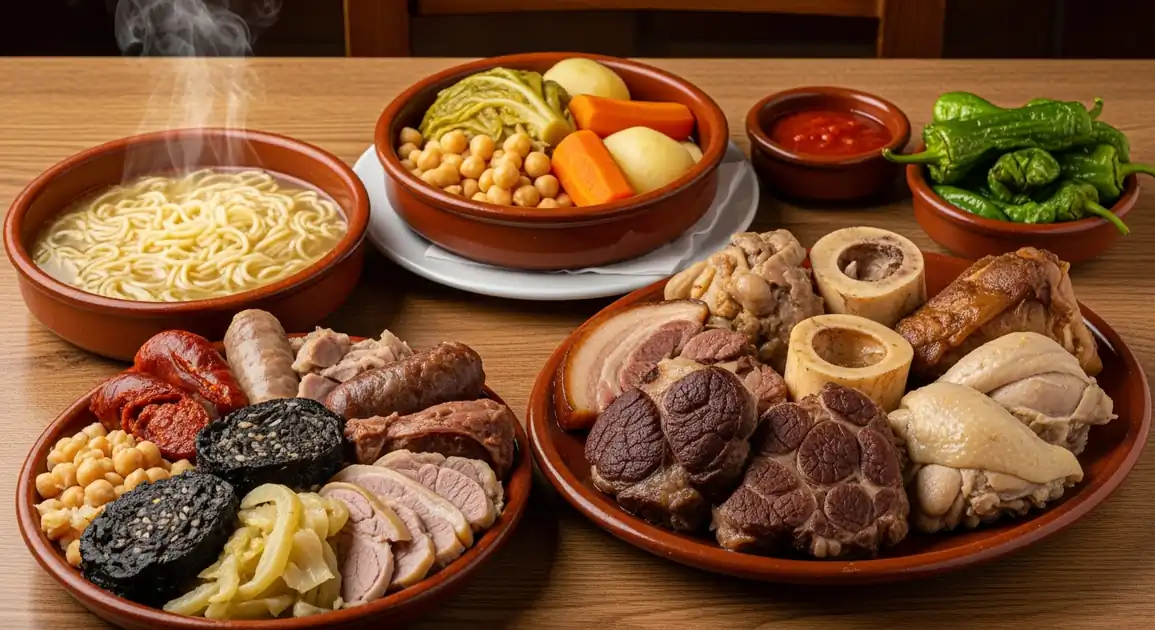Cocido Madrileño
Cocido Madrileño

Description
Cocido Madrileño is intrinsically linked to Madrid, the capital city where it originated and remains a culinary emblem. While variations of chickpea stews exist across Spain, the specific preparation, ingredients, and three-course serving ritual define the Madrileño version. It's primarily found in Madrid, especially during winter, and less commonly encountered with the same authenticity elsewhere in the country.
Dietary Information
Serving information
Serving style
Served hot in three distinct courses ('vuelcos'): soup, chickpeas/vegetables, meats. Eaten with a spoon and fork.
Quick facts
Lunch service, roughly 1 PM - 4 PM. Few places might offer it for dinner, but this is uncommon.
Safety Tips
What to Look For
-
All three courses served piping hot
Ensures the food is freshly prepared or properly held at safe temperatures, critical for a slow-cooked dish.
-
Tender meat and fully cooked chickpeas/vegetables
Indicates thorough cooking, essential for safety and digestibility.
-
Reputable restaurant known for Cocido
Established places specializing in Cocido usually maintain high standards of preparation and ingredient sourcing.
-
Clear, flavorful broth (first course)
A well-made broth is a sign of quality preparation, although cloudiness isn't necessarily a safety issue.
What to avoid
-
Lukewarm servings
Food served at improper temperatures poses a significant food safety risk.
-
Undercooked chickpeas or tough meat
Could indicate insufficient cooking time, potentially compromising safety and quality.
-
Restaurants with poor hygiene ratings or reviews
General cleanliness is paramount for food safety.
-
Excessively greasy broth or meats
While Cocido is rich, extreme greasiness might indicate poor fat skimming or ingredient quality, though not a direct safety threat.
Price information
Price range
Budget tips
- Cocido is usually offered as a fixed-price menu ('menú del día' style, but often pricier).
- Prices vary significantly based on the restaurant's fame and location.
- It's a very filling meal, often sufficient for lunch without needing dinner later.
- Sharing is generally not an option as it's priced per person.
Value indicators
- Served in the traditional three 'vuelcos'.
- Generous portions for each course.
- Quality of meats (chorizo, morcilla, etc.).
- Tenderness of chickpeas and vegetables.
- Richness and flavor of the broth.
Where to Find This Dish
Madrid City Center
Highest concentration of traditional restaurants serving Cocido Madrileño.
Sol, Gran Vía, La Latina, Chueca, Malasaña
Lunch (Winter)
Specialty Restaurants
Restaurants explicitly known for their Cocido (e.g., La Bola, Malacatín, Lhardy, Casa Carola in Madrid).
Search 'best cocido Madrid'
Lunch (Winter, often specific days)
Vendor Tips
- Book well in advance, especially for famous restaurants or if dining on a Wednesday (traditional Cocido day).
- Confirm availability and serving days/times before visiting, especially outside peak winter season.
- Come hungry – it's a substantial meal.
How to Order
Regional Variations
-
Inclusion of 'Relleno'
(Cocido con Relleno)
Some recipes include a 'relleno', a type of savory dumpling made from breadcrumbs, egg, garlic, and parsley, cooked in the broth and served usually with the meats.
-
Different Meat Cuts
(Variedad de Carnes)
Minor variations exist in the exact cuts of pork, beef, or chicken used, or the type of chorizo/morcilla, depending on the restaurant or family tradition.
-
Serving Style Adjustments
(Estilo de Servir)
While traditional service is three separate vuelcos, some less traditional venues might combine the second and third courses for simplicity.
-
Vegetable Additions
(Verduras Adicionales)
Occasionally, other vegetables like turnips or green beans might be included, though potato, carrot, and cabbage are standard.
Cultural context
History
The origins of Cocido Madrileño trace back to medieval Spain, likely evolving from the Sephardic dish 'adafina' and related to Spain's tradition of 'olla podrida' (rich pot stews). Initially a humble dish providing sustenance for workers, it gradually gained complexity and status, becoming a beloved staple across Madrid's social strata, from modest homes to renowned restaurants established in the 19th century. It embodies the gastronomic heritage of Madrid.
Local significance
Cocido Madrileño is a cornerstone of Madrid's gastronomy, representing tradition, history, and the city's culinary identity.
Eating customs
- Each course is typically finished before moving to the next.
- It's common to drink red wine with Cocido.
- Taking leftovers home ('para llevar') might be possible in some places due to large portions.